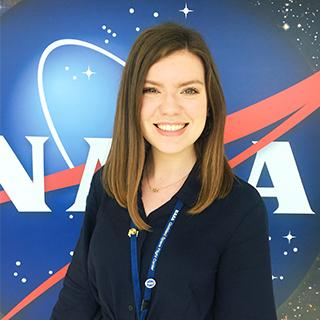
Michaela B. Allen
NASA Citizen Scientist
Education
Angelo State University
Physics
Michaela is a graduate student at Texas A&M University-Commerce. A NASA citizen science project convinced her to pursue a career in astronomy.
What motivated you to volunteer as a NASA citizen scientist? How did you learn about NASA citizen science?
Before I was a physics major in undergrad, I was really interested in astronomy and space, and I liked to keep up with everything NASA was doing. I remember reading an article about Backyard Worlds: Planet 9, a new NASA citizen science project that was getting ready to be launched where you could discover new objects in space, and that seemed really cool to me. I made an alarm for the day the project launched and got to working on it that very day.
Within two weeks of the project launch, I had changed my major to physics and was spending every minute of free time classifying objects!
What are your favorite NASA citizen science projects to work on, and why?
Backyard Worlds is definitely my favorite citizen science project. This project is what made me change my major to physics and made me want to do research in astronomy. It’s now four years later, and I am getting ready to graduate with my master’s degree in physics. I also have enjoyed working on Disk Detective and Galaxy Zoo in the past!
What do you do when you’re not doing science with NASA? Tell us about your job and your hobbies.
I am getting ready to graduate from Texas A&M University-Commerce this summer with my master’s degree in physics, so most of my spare time is just me working on my thesis. I am studying pulsating white dwarfs in the open star cluster Messier 67. My favorite part of studying astronomy is getting to use telescopes! I've been on several observing runs at McDonald Observatory in Fort Davis, Texas, where I used a 2.1-meter telescope to make measurements of RR Lyrae variable stars’ luminosity, or brightness, and pulsation period, which is the length of time between the instances of peak luminosity. I find the process of taking data – essentially just numbers – and turning them into useful information to learn all sorts of things about stars fascinating! As a plus, observing runs are fun! I am definitely a night owl, so I love getting to stay up all night looking at the night sky.
In the rare moments where I’m not working on my thesis, I really enjoy reading high-fantasy novels, and I love hiking and exploring the outdoors.

What have you discovered or learned as a NASA citizen scientist?
One of the biggest things I’ve learned while working on Backyard Worlds is just how big of a community there is for citizen science and how kind everyone in that community is! I never imagined I would have friends all over the world and that citizen science would bring us together!
Which peer-reviewed research publications have you contributed to through your citizen science work? What was your role in the research and writing process?
I am a co-author on a couple of peer-reviewed publications from Backyard Worlds, including “A 3 Gyr White Dwarf with Warm Dust Discovered via the Backyard Worlds: Planet 9 Citizen Science Project” by Debes et al., published in The Astrophysical Journal Letters in 2019, and “Spitzer Follow-up of Extremely Cold Brown Dwarfs Discovered by the Backyard Worlds: Planet 9 Citizen Science Project” by Meisner et al., published in The Astrophysical Journal in 2020. During the summer of 2018, I was able to be an intern under Dr. Marc Kuchner for Backyard Worlds at NASA’s Goddard Space Flight Center. The work I did that summer helped to contribute to the research presented in these papers.
What have you learned about the process of science from your time on NASA citizen science projects?
Due to my time as both a citizen scientist and science team member for Backyard Worlds, I have learned a lot about the process of science. One of the biggest things, and perhaps most obvious, is just how much work goes into every single project. There are countless people working "behind the scenes" to provide and prepare the data for citizen scientists to analyze and countless more who then inspect what the citizen scientists have submitted. It really is a process, and citizen scientists play a vital role.
What advice would you give to others who might want to volunteer with NASA citizen science?
Just do it!! But be warned - it will take up all of your free time when you find a project you love!
